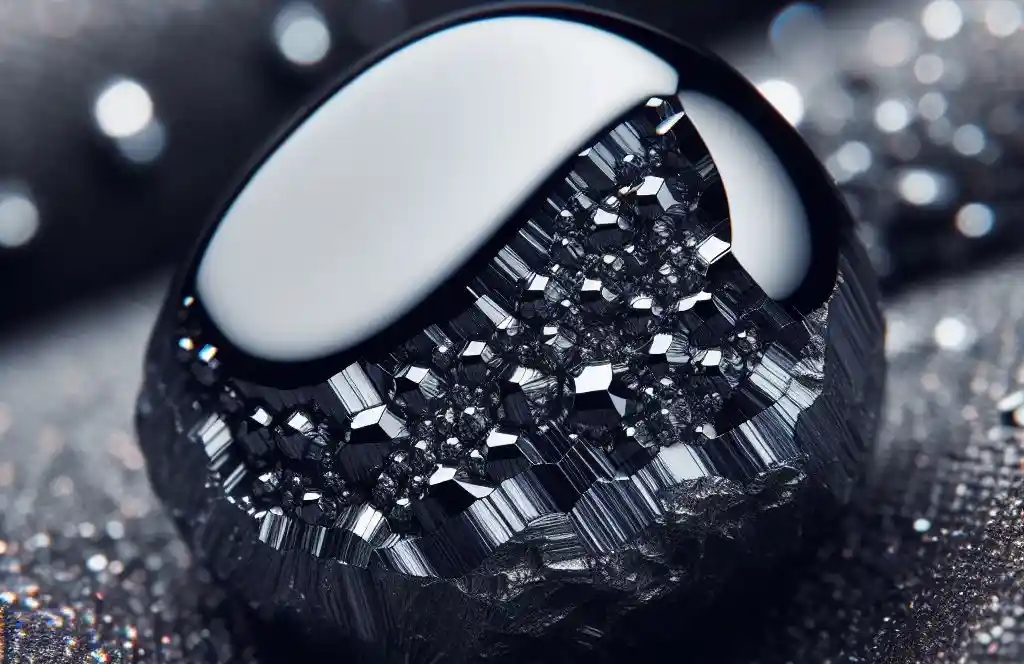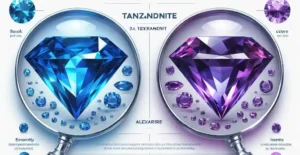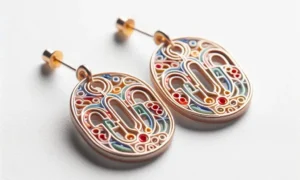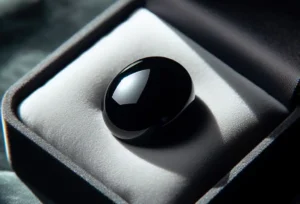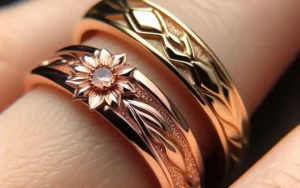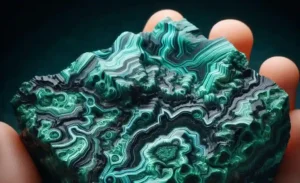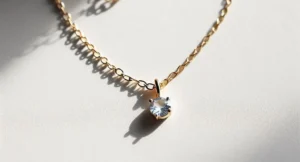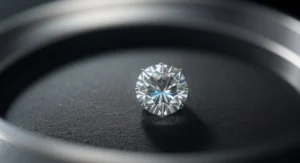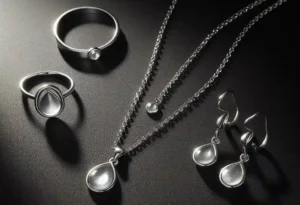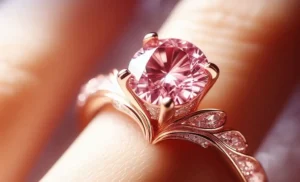How to Tell if Hematite is Real? In the world of gemstones and minerals, hematite holds a special place with its metallic sheen and weighty presence, symbolizing grounding and protection in many cultures.
In this detailed guide, we’ll explore various methods to authenticate hematite, ensuring that what you hold in your hand is as real as the earth it came from.
How to Tell if Hematite is Real?
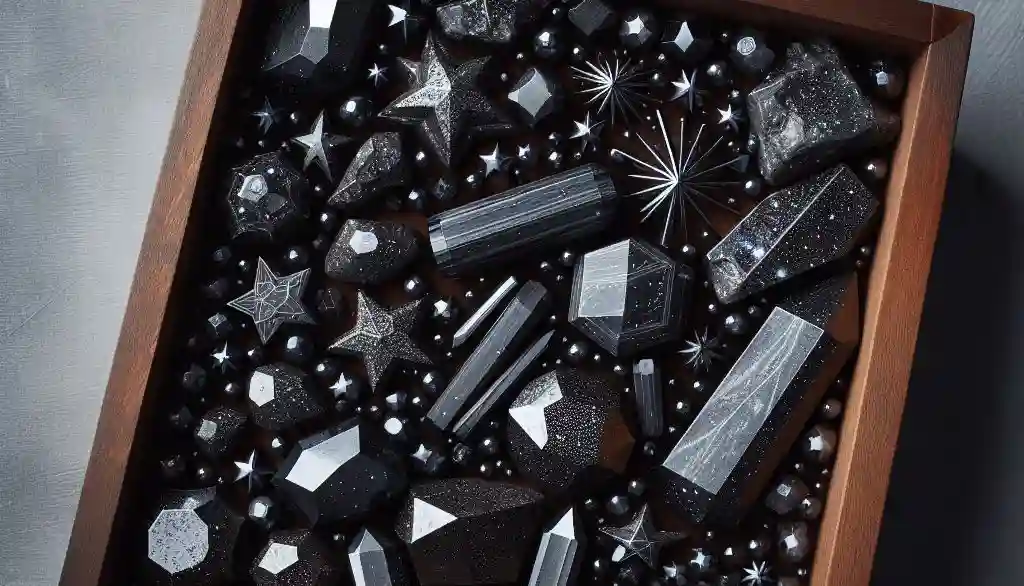
– Conduct the magnetism test: Genuine hematite should exhibit a slight magnetic pull, indicating the presence of maghemite. Be wary of strong magnetic responses, which are characteristic of imitations.
– Feel its weight and texture: Authentic hematite has a noticeable heaviness due to its high iron content. It should feel cool and smooth to the touch, a result of its density and thermal conductivity.
– Perform the streak test: Dragging genuine hematite across an unglazed ceramic surface will leave a reddish-brown streak, a clear sign of its iron oxide composition. This is a distinguishing feature not easily replicated by substitutes.
– Examine visually for authenticity: Look for a consistent metallic sheen and uniform coloration. Imitations may show uneven color distribution or textures that do not align with hematite’s natural appearance.
– Seek professional verification if uncertain: For definitive confirmation of authenticity, consult a gemologist or mineralogist who can provide detailed analysis through advanced diagnostic tools.
– Consider the source: Prioritize purchasing from reputable dealers known for their commitment to authenticity and ethical sourcing practices, which increases the likelihood of obtaining genuine hematite.
Understanding Hematite’s Unique Properties
Hematite stands out in the mineral world due to its distinctive physical and chemical characteristics. As an iron oxide compound, it naturally possesses a high iron content, which directly contributes to its significant density and metallic appearance.
These features not only make hematite unique but also provide it with a weightiness that is palpable when held, distinguishing it from lighter, less substantial imitations. Furthermore, hematite’s hardness is another notable attribute. Ranking at 5.5 to 6.5 on the Mohs scale of mineral hardness, it is resistant to scratching and abrasion, which often surpasses the durability of materials used to mimic its appearance.
One of the most remarkable aspects of hematite is its ability to reveal a reddish hue when found in powder form or when a streak is performed. This characteristic streak, distinct from its polished dark exterior, is a direct result of its iron composition.
It’s a property that cannot be accurately replicated by artificial counterparts, providing a reliable method for distinguishing genuine hematite from forgeries.
This unique combination of density, hardness, and the revealing reddish streak due to its iron content, sets hematite apart, making it a subject of fascination and a valuable component in various applications, from jewelry to grounding and protective amulets in cultural practices.
The Magnetism Test: A Simple Yet Effective Method
The magnetism test is a popular and accessible way to evaluate the authenticity of a hematite piece. Hematite’s relationship with magnetism is nuanced due to its iron oxide composition. When conducting this test, a slight magnetic reaction is what you’re aiming for; it suggests the presence of maghemite, a mineral alteration of hematite that carries magnetic properties.
This nuanced reaction aligns with the natural characteristics of genuine hematite, which is known to contain traces of maghemite, giving it a weak magnetic response.
On the other hand, a strong magnetic attraction is a red flag. Many counterfeit hematite products are engineered to exhibit a pronounced magnetism, a trait that appeals to the uninformed buyer but deviates from the authentic stone’s subtler magnetic qualities. To perform this test accurately, use a strong magnet and closely observe the hematite’s reaction.
The key lies in the strength of the attraction: a genuine piece will respond with a light pull, distinguishing itself from more heavily magnetized imitations. This simple yet revealing method plays a crucial role in the verification process, contributing to a holistic assessment when combined with other tests outlined for determining hematite’s authenticity.
Heft and Texture: Feeling the Weight of Authenticity
The tactile experience of holding a piece of genuine hematite is both unique and revealing. Due to its high iron content, authentic hematite possesses a significant density that is immediately noticeable.
This density translates into a distinctive heft; when lifted, genuine hematite feels heavier than many other stones of comparable size. This test, requiring no special tools or conditions, is a straightforward way to gauge authenticity through physical sensation.
Another aspect to consider is the texture of the mineral. Genuine hematite has a notably smooth surface, which when combined with its density, imparts a cool sensation to the touch.
This coolness, characteristic of genuine hematite, is a direct result of its high thermal conductivity. This physical property allows it to rapidly absorb heat from its surroundings, including the warmth of human skin.
The surface of real hematite also exhibits a unique metallic sheen, a visual and tactile feature that imitations often fail to replicate accurately. Counterfeit products may mimic the appearance to some extent but usually fall short in replicating the combined effect of hematite’s weight, texture, and temperature.
Engaging with hematite through these tactile evaluations—feeling its weight, assessing its smoothness, and noting its temperature—provides invaluable insights into the stone’s authenticity. These simple observations can significantly enhance one’s ability to identify genuine hematite, enriching the experience of collecting and utilizing this remarkable mineral.
The Streak Test: Uncovering the True Color
The streak test is a straightforward yet revealing technique widely used in mineral identification, and hematite is no exception to its efficacy. This method requires dragging the stone across the surface of an unglazed ceramic plate or tile, thereby revealing the true color of the mineral’s powder form.
When applied to hematite, the outcome is a reddish-brown streak, a clear indication of its authenticity. This distinctive coloration is attributed to hematite’s iron oxide content, a characteristic that synthetic substitutes and other minerals find challenging to mimic accurately.
Performing the streak test is not only simple but also highly effective in differentiating genuine hematite from its imitations. While the polished surface of hematite may appear dark and metallic, the streak it leaves is notably different from its exterior, serving as a reliable indicator of its true identity.
This method transcends the limitations of visual appraisal, offering a tangible trait that can be used to authenticate the mineral.
It is essential to note that while the streak test is a valuable tool in verifying hematite, it should ideally be conducted alongside other tests to form a comprehensive assessment of the stone’s authenticity.
By combining the streak test with other evaluative methods, one can develop a more nuanced understanding of the mineral in question, enhancing the ability to identify genuine hematite with greater confidence.
Visual Inspection: Spotting Inconsistencies in Imitations
A discerning eye can often detect the subtleties that differentiate authentic hematite from its imitations through careful visual inspection. Genuine hematite is characterized by its smooth, metallic sheen and consistent coloration, reflecting its natural origin.
When examining a piece, look for uniformity in its appearance. Variations, when present, should appear inherent to the stone, seamlessly integrated into its overall aesthetic.
Imitations, however, may betray themselves through several telltale signs. Anomalies such as patchy or uneven color distribution, surfaces that exhibit an unnaturally glossy or matte finish, or patterns that seem artificially introduced, are red flags.
These inconsistencies often arise from manufacturing processes attempting to replicate hematite’s natural beauty but falling short due to the limitations of synthetic materials.
Additionally, pay attention to the edges and surfaces for signs of wear or chipping that may reveal underlying materials differing in color or texture from the exterior. Such discrepancies are uncommon in genuine hematite, as its solid composition and hardness lend it a consistent appearance throughout.
By focusing on these visual cues and comparing them against the known characteristics of hematite, collectors and enthusiasts can sharpen their ability to spot imitations. Remember, while visual inspection is a powerful tool in assessing authenticity, it’s most effective when used in conjunction with other evaluative methods outlined in this guide.
Professional Verification: When in Doubt, Consult an Expert
Navigating the intricate world of mineral authenticity, particularly with hematite, can sometimes lead you into uncertain territory. Even after utilizing various at-home methods to discern genuine hematite from its imitations, you may find yourself in need of a more definitive answer.
This is where the expertise of a professional gemologist or mineralogist becomes invaluable. These experts have access to advanced diagnostic tools, such as spectroscopy, which can analyze the mineral at a molecular level, providing indisputable evidence of its authenticity.
Additionally, a professional evaluation might include comprehensive tests that assess the stone’s density, reflectivity, and other physical properties that are difficult to accurately gauge without specialized equipment. By consulting with an expert, you not only benefit from their extensive training and experience but also gain peace of mind, knowing the true nature of your hematite piece.
This step is particularly recommended for individuals who have significant investments in their collections or who rely on the energetic properties of hematite for wellness practices. Remember, while the initial tests outlined provide a strong foundation for authenticity, there’s no substitute for the assurance and accuracy that professional verification offers.
The Importance of Sourcing from Reputable Dealers
When venturing into the acquisition of hematite, prioritizing purchases from well-regarded dealers and artisans is a crucial step toward guaranteeing the stone’s authenticity.
These vendors, who have built a reputation on the integrity of their offerings, are more inclined to conduct thorough vetting of their inventory, ensuring that the minerals and gemstones they sell are genuine.
Such dealers are typically transparent about the origins of their hematite pieces, often willing to provide documentation or certificates attesting to their authenticity. This level of transparency is a testament to their commitment to quality and the authenticity of their products.
Moreover, established dealers often have direct connections to ethical sourcing channels, ensuring that the hematite is not only genuine but also acquired through practices that respect environmental and labor standards. Engaging with these reputable sources offers an added layer of confidence, knowing that your purchase supports responsible mining and trading practices.
While it may be tempting to opt for seemingly attractive deals from less known sources, the risks of encountering counterfeit or misrepresented items increase significantly. In contrast, reputable dealers invest in building trust with their clientele through consistent quality and transparency, making them invaluable allies in the pursuit of authentic hematite.
Their expertise and dedication to authenticity can guide both seasoned collectors and newcomers, making the journey into hematite collection a more secure and rewarding experience.
Hematite Imitations: Common Substitutes to Be Aware Of
In the realm of gemstones, hematite’s unique allure makes it a target for imitation. Familiarity with common substitutes can enhance one’s ability to discern genuine hematite. Among these substitutes, steel slag emerges as a prevalent mimic.
Originating from the steel-making process, this byproduct can superficially resemble hematite’s metallic sheen and density but lacks the stone’s specific physical and chemical properties, such as the reddish-brown streak indicative of genuine hematite.
Another notable imitation is hematine, also known as “magnetic hematite.” This synthetic material is engineered to replicate the appearance and, to some extent, the magnetic properties of hematite.
However, hematine often exhibits a much stronger magnetic response than natural hematite, which should only display a slight magnetic attraction due to the presence of maghemite. This distinction is crucial in differentiating between the two.
Additionally, it’s worth noting the existence of various other artificial composites marketed under the guise of hematite. These products may mimic the look and feel of hematite to varying degrees but ultimately fail to embody the stone’s inherent properties and energetic qualities.
Being vigilant about these common substitutes, and employing the authentication methods outlined earlier, significantly aids in ensuring the hematite in your possession is genuine, safeguarding both the investment and the intended benefits of this remarkable mineral.

